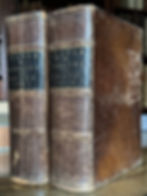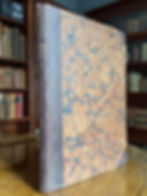Pare, Works, 1649
The Workes of that Famous Chirurgion, Ambrose Parey, Translated out of Latin and compared with the French by Tho. Johnson. Where unto are added three tractates out of Adrianus Spigelius of the veins, arteries, & nerves, with large figures. Also a table of the bookes and chapters. London, 1649.
Folio in later half brown leather with marbled boards, and subsequent hinge/spine repairs. Author and title label on spine. Shelf wear. Scattered scuffs and scrapes. Corners bumped and split. New end papers. Red page edges. Library stamp on title page. Title page with two gutter stains from prior tape repair. Damp stain at head of gutter, nearly gone by pg 5, also in gutter at rear of book, from index through Spigelius. Mostly bright, though some leaves a toned. Rear plates trimmed. Binding tight.
3 plates at the rear (Spigelius). We count 302 figures (though this number is a bit arbitrary as some may be one figure with multiple subjects, or multiple confluent figures).
New ffep, title, (20), 787, (8), title, (2), 32, 1 plate, 35-50, 2 plates (r/v), (1), blank, rfep.
Though Ambroise Pare was a surgeon, this book includes many chapters that range far afield from medicine and surgery, including (but not limited to) incubi and succubi, miner’s encounters with subterranean demons, poisons, embalming, Pare’s journeys and/or voyages, discussions of why Pare refused to prescribe mummy dust, and copiously illustrated discussions of diverse and sundry animals and monsters. The more common topics of anatomy, physiology, wounds/trauma, diseases/pathology, surgical instruments, surgical/operative techniques, tumors, obstetrics, prescriptions/pharmaceuticals, and symptomatology are, of course, thoroughly incorporated into this work as well.
Pare (1510 – 1590) remains one the most famous surgeons in history. He was a contemporary of Andreas Vesalius. Spigelius was an anatomist in Padua who studied under Fabrici.
“The figures of Vesalius were copied and plagiarized from the beginning. Among the more shameless (was) Amboise Pare, who reproduced them without acknowledgement in 1551 and afterwards....” (Singer, 1925).
On a personal note, I must add that this book really embodies almost all that is wonderful about collecting antiquarian books. It is in English so it is still readable for most Western eyes, yet that English is 17th century so it renders it slightly curious to most 21st century readers—and gives it an added veneer of antiquity. The topics contained in each chapter are fantastic and the plates are mythological and speculative. It includes journey narratives, and blends theology, science, and philosophy seamlessly. Its folio size also adds an air of authority to it as well. Honestly, I think the only content features that are typically sought among rare book collectors which are not contained in this work are maps and scenes.
The first French edition was 1575 (Garrison-Morton 5565) and the fifth, most complete, edition was 1598. The first (1634) English edition was rendered from the 1582 Latin edition (supplemented by the French, as the title page indicates). We offer here the 1649 second English edition.















